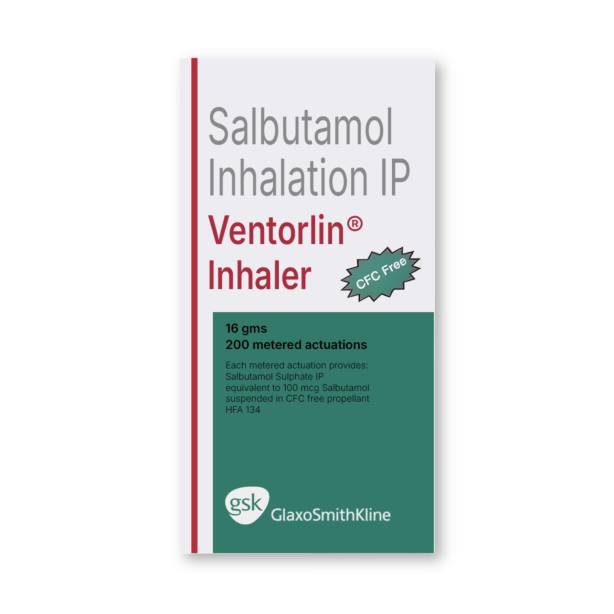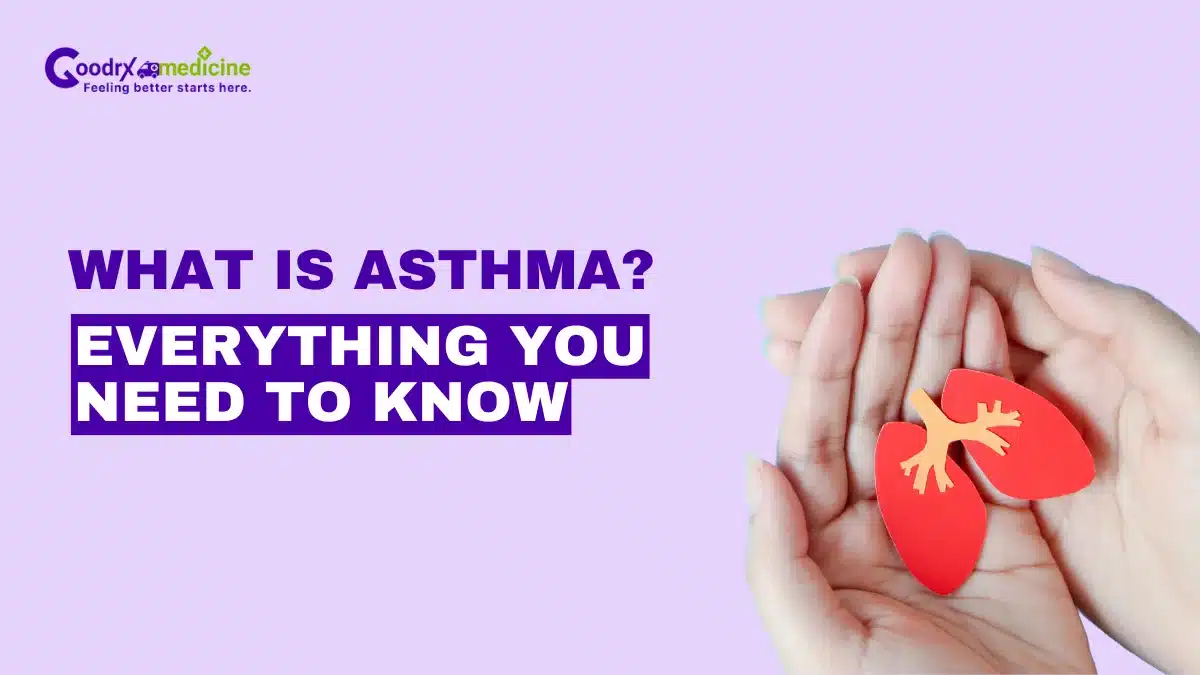Have you ever wondered why some people suddenly struggle to breathe during a jog or keep an inhaler close at all times? Asthma might be the reason.
This chronic condition affects more than 250 million people worldwide and continues to rise, making it one of the most common respiratory illnesses today.
Despite its widespread nature, many still misunderstand Asthma, how it develops, and why it varies so much from person to person.
In this article, you’ll learn all about Asthma, its symptoms, different types, common triggers, and how to manage this condition effectively.
What is Asthma?
Asthma is a chronic lung condition in which inflammation and airway narrowing make breathing difficult. When someone with the condition comes in contact with triggers, like pollen, cold air, or exercise, their immune system releases chemicals that cause the airway walls to swell, produce extra mucus, and tighten nearby muscles.
These changes can occur suddenly in an attack or build up gradually, leading to episodes of wheezing, coughing, or chest tightness. Some people experience mild discomfort, while others may struggle to catch their breath without treatment. Recognizing how these airway reactions work helps you spot the early warning signs and respond quickly.
Save up to 90% on your medicine bills

Aerocort Inhaler 50 mcg + 50 mcg

Bolstran 150 mg Injection

Ventorlin CFC Free Inhaler 100 mcg/18 mg

Asthalin HFA Inhaler 100 mcg
How to spot Asthma: Common signs and symptoms
Asthma doesn’t look the same for everyone. For some, it might feel like a mild, annoying cough that won’t go away; for others, it can show up as sudden breathlessness that stops them.
Here are some of the most common symptoms of Asthma to watch for:
- Shortness of breath: You may feel like you can’t breathe properly, especially during physical activity or at night.
- Wheezing: It is a high-pitched whistling sound when you breathe, often most noticeable when exhaling.
- Persistent coughing: This can worsen at night, early in the morning, or after exercise.
- Chest tightness or pain: It may feel like something is squeezing your chest or sitting on it.
- Trouble sleeping: The symptoms often worsen at night, making it hard to get restful sleep.
- Increased mucus production: Your airways may produce more mucus, which can clog your lungs and worsen symptoms.
These symptoms can range from mild to severe and may come and go. Cold air, allergens, smoke, stress, or respiratory infections can also trigger them.
Types of Asthma
Knowing your specific type of Asthma is key to managing it effectively. Below, we break down the most common types in detail:
Allergic Asthma
Allergic Asthma is the most common type and is triggered by exposure to allergens—substances that cause an allergic reaction. Common triggers include:
- Pollen from trees, grass, and weeds
- Pet dander (skin flakes from animals)
- Mold spores
- Dust mites
- Cockroach droppings
When a person with allergic Asthma breathes in one of these allergens, their immune system overreacts, causing inflammation in the airways. This leads to symptoms like wheezing, coughing, chest tightness, and shortness of breath.
It often starts in childhood and is linked to other allergic conditions like hay fever, Eczema, or food allergies. Managing it typically involves allergen avoidance, antihistamines, and inhaled corticosteroids.
Non-Allergic Asthma
This type is not triggered by allergens but by other environmental or internal factors, such as:
- Cold air
- Strong smells (perfumes, cleaning products)
- Air pollution or smoke
- Respiratory infections
- Stress and emotional changes
Non-allergic Asthma tends to develop later in life and can be more persistent. People with this type often don’t respond to allergy medications, and managing it focuses more on reducing inflammation through inhalers and identifying non-allergen triggers. It can sometimes be harder to diagnose due to the lack of allergic signs.
Exercise-induced Asthma
People with this type have symptoms during or shortly after physical activity. Symptoms may include:
- Shortness of breath during exercise
- Coughing, especially in cold weather
- Chest pain or tightness
- Wheezing after activity
This type is more common in athletes and children, but can occur at any age. It’s not exercise that causes Asthma, but the rapid breathing of cold, dry air irritates the airways.
Occupational Asthma
It occurs when exposure to irritants or allergens in the workplace causes symptoms. Common triggers include:
- Chemical fumes
- Dust
- Latex
- Animal proteins (common in lab or vet work)
- Flour or grain (in the baking and milling industries)
This type may improve on weekends or vacations and worsen during workdays. It is especially common in industrial chemicals, farming, healthcare, and cleaning jobs.
Cough-variant Asthma
Cough-variant Asthma presents primarily as a chronic, dry cough, without wheezing or shortness of breath. This persistent cough may be:
- Worse at night
- Triggered by exercise or cold air
- Mistaken for a lingering cold or allergy
Because of its unusual presentation, cough-variant Asthma is often misdiagnosed as bronchitis or post-nasal drip. It’s more common in children but can occur in adults, too. Diagnosis often involves lung function tests or a medication trial to see if symptoms improve.
Eosinophilic Asthma
It is a rare but severe form that involves high levels of Eosinophils, a type of White Blood Cell (WBC) that causes inflammation. It often appears in adulthood and can lead to chronic symptoms, such as:
- Frequent Asthma attacks
- Severe breathing issues despite using standard inhalers
- Sinus infections or nasal polyps
Eosinophilic Asthma may not respond well to typical medications, so treatment often includes corticosteroids or targeted therapies like biologics (e.g., mepolizumab or bevacizumab) that reduce Eosinophil levels.
Who is at risk of developing Asthma?
Asthma can affect anyone, but some people are more likely to develop it than others due to genetic and lifestyle factors. The following are some of the factors that can cause this condition:
- Family history: If it runs in your family, especially in a parent or sibling, your chances of developing it are higher. Genetics significantly affects how your immune system reacts to specific triggers.
- Age: It often begins in childhood, but adults can develop it too. Kids with frequent respiratory infections or allergies are especially at risk.
- Gender: It is more common in boys in early childhood. However, it becomes more common in females after puberty.
- Allergies: People with allergic conditions like hay fever, Eczema, or food allergies are more prone to allergic Asthma.
- Exposure to irritants: Breathing in cigarette smoke (even secondhand), air pollution, dust, or harsh chemicals regularly can increase your risk, especially if you’re already sensitive.
- Obesity: Excess weight can put pressure on the lungs and make it harder to breathe. Obesity is linked to higher inflammation, which can worsen the symptoms or even contribute to its development.
- Occupational exposure: Jobs that involve dust, fumes, or chemicals, like farming, construction, or cleaning, can increase the risk of work-related Asthma, especially over time.
- Respiratory infections in childhood: Frequent or severe lung infections early in life may affect lung development, increasing the risk later.
Being aware of these factors doesn’t guarantee you’ll develop Asthma. Still, it does highlight the importance of keeping your lungs healthy, especially if you or your child falls into a higher-risk category.
How to treat and manage Asthma?
Managing Asthma is all about controlling symptoms, preventing flare-ups, and ensuring you can go about your daily life without constant interruptions. While there is no cure, the good news is that most people can manage it very well with the right treatment plan and lifestyle choices.
- Controller medications: These are daily medications designed to keep inflammation in the airways down. The most common ones are inhaled corticosteroids, which help prevent symptoms from even starting. They’re not for quick relief but for long-term control.
- Rescue inhalers: Also known as reliever medications, these are fast-acting bronchodilators used when symptoms flare up suddenly. They work quickly to open the airways and make breathing easier, especially during an Asthma attack.
- Long-term medications: Some people need additional support, especially if their Asthma is moderate to severe. This can include leukotriene modifiers, Long-Acting Beta-Agonists (LABAs), or newer options like biologic therapies targeting specific immune system pathways.
- Asthma action plan: Your doctor can help you create a personalized plan that outlines your daily routine, medication schedule, and steps to take when symptoms get worse.
- Lifestyle changes: Avoiding triggers is just as important as medication. This might mean staying indoors during high pollen days, quitting smoking, using air purifiers, or avoiding pets if you’re allergic. Exercise is encouraged, but with proper warm-ups and medication if needed.
- Regular checkups: Staying in touch with your healthcare provider ensures your treatment stays effective. Asthma can change over time, so your plan may need updates.
- With consistent care and the right approach, most people with Asthma live whole, active lives.
Conclusion
Recognizing your warning signs is the first step, no matter how Asthma appears—whether it’s a nagging cough, a tight chest, or sudden wheezing. Take a moment to learn what sets off your symptoms and work with your doctor to build a simple action plan that fits your life.
Daily controller medications and a trusty quick-relief inhaler can keep most flare-ups at bay, while small habits—like checking pollen counts or using an air filter—add extra protection.
Remember, it’s not about avoiding every possible trigger but knowing how to respond when Asthma strikes.
Stay in touch with your healthcare team, adjust your plan as needed, and celebrate each symptom-free day. With preparation and the proper support, breathing easier can become your new regular.

Frequently Asked Questions
Can Asthma go away?
Asthma usually doesn’t go away completely, as it’s a chronic condition, but symptoms can improve or even enter remission for months or years with good management and treatment. Some children may outgrow the condition as they age, but symptoms can return if triggers are present.
Is drinking a lot of water good for Asthma?
Yes, staying well-hydrated can help manage Asthma. Drinking enough water keeps mucus thin, making it easier to clear airways and breathe better. It also supports overall lung function and health.
How is Asthma diagnosed?
Asthma is diagnosed using your medical history, a physical exam, and lung function tests like spirometry and peak flow. Additional tests, such as a methacholine challenge or allergy tests, may help confirm the diagnosis. No single test is conclusive—doctors rely on a combination of results and symptoms.
How to use an Asthma inhaler?
To use an Asthma inhaler, shake it well, exhale fully, place it in your mouth, and press the inhaler while breathing deeply. Hold your breath for approximately 10 seconds, then exhale slowly. Always follow your doctor’s instructions and use a spacer if recommended.
When referencing outside resources, GoodrxMedicine always provides full citations. To learn more about the measures we use to maintain the quality of our content, please review our Content Information Policy.











